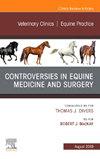马的麻醉和肌病。
IF 1.1
3区 农林科学
Q3 VETERINARY SCIENCES
Veterinary Clinics of North America-Equine Practice
Pub Date : 2024-12-30
DOI:10.1016/j.cveq.2024.11.008
引用次数: 0
摘要
马先前存在的肌肉疾病通常是微妙的,可能只有在麻醉期间或麻醉后才会变得明显。兽医学的进步,以及该领域知识和研究的增加,有助于最大限度地减少与麻醉有关的问题。充分的麻醉前评估,早期疾病诊断和适当的管理对于最小化全麻期间神经肌肉系统的风险至关重要。本文章由计算机程序翻译,如有差异,请以英文原文为准。
Anesthesia and Myopathies of Horses
求助全文
通过发布文献求助,成功后即可免费获取论文全文。
去求助
来源期刊
CiteScore
2.10
自引率
9.10%
发文量
55
审稿时长
>36 weeks
期刊介绍:
Veterinary Clinics of North America: Equine Practice presents those in the veterinary medicine field with the most current treatment of horses, updates on the latest advances, and provides a sound basis for choosing treatment options. Published 3 times a year—in April, August, and December—each issue features expert, state-of-the-art reviews on a single topic in equine practice, including gastroenterology, imaging, infectious diseases, nutrition, orthopedics, pathology, pharmacology and therapeutics, and surgery.

 求助内容:
求助内容: 应助结果提醒方式:
应助结果提醒方式:


